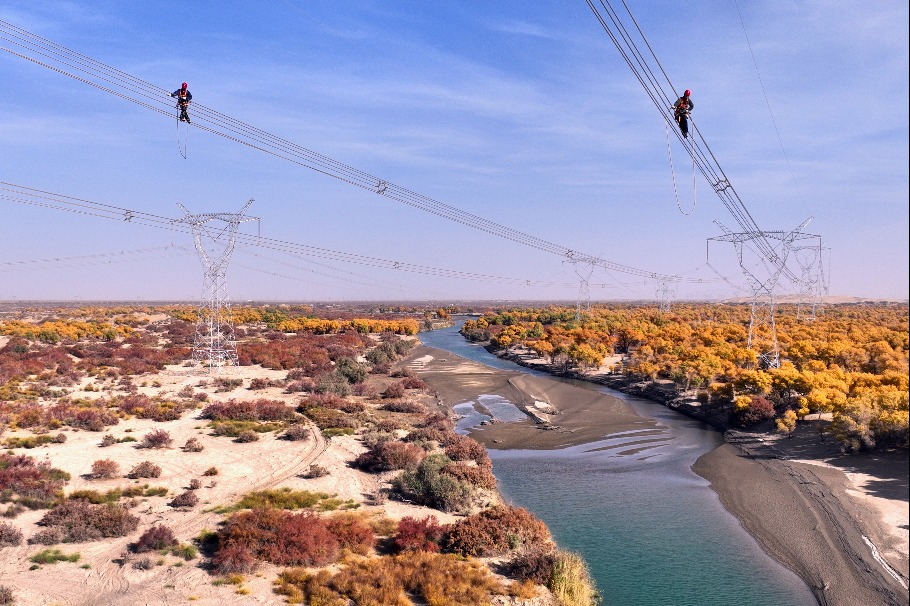Climate action booster


China needs an overall non-CO2 greenhouse gases emissions reduction goal as well as specific reduction measures
On June 17, China ratified the Kigali Amendment to the Montreal Protocol-which calls for an 85 percent reduction in hydrofluorocarbons production and use by 2047 to avoid an up to 0.4 C rise in global temperatures by the end of the century. China's ratification will be effective from Sept 15.
HFCs are powerful greenhouse gases that are used in cooling technologies, such as air conditioners and refrigeration. China's ratification of the Kigali Amendment could be the beginning of a comprehensive move by the country to control emissions of all non-CO2 greenhouse gases. During a meeting with French and German leaders on April 16, President Xi Jinping declared that China would ratify the amendment and he also committed to reducing all non-CO2 GHG emissions.
After the meeting in Shanghai between US Special Presidential Envoy for Climate John Kerry and China Special Envoy for Climate Change Xie Zhenhua in late April, the two countries released a joint statement of cooperation on climate activity, highlighting non-CO2 GHGs.
Non-CO2 GHGs include methane (CH4), nitrous oxide (N2O) and fluorinated-gases (F-gases), all of which together contribute to around 30 percent of the global warming effect.
China's overall non-CO2 GHG emissions have been rising over the past decade. According to data from China's Second Biennial Update on Climate Change, it exceeded 2 billion tons of CO2-equivalent in 2014, accounting for 18 percent of total GHG emissions. Methane, nitrous oxide and the F-gases (mainly HFCs) accounted for 56 percent, 30 percent and 14 percent, respectively, of these emissions.
Non-CO2 GHGs, however, have not yet received sufficient policy attention in China's overall carbon mitigation effort. Now that China has announced that it will achieve carbon neutrality before 2060, the race is on to deliver on this ambitious vision. Every carbon-reducing measure will have to be considered.
Projections show that without new policy interventions, China's non-CO2 GHG emissions will continue to rise, reaching 3.4 billion to 3.9 billion tons of CO2-equivalent by 2050, an increase of 50 percent to 60 percent from 2015. Of these, the largest share will be methane, while the fastest growing will be F-gases.
Adopting cost-effective non-CO2 GHG reduction measures under Kigali will help China achieve its carbon peaking and neutrality goals. If China's non-CO2 GHG emissions will plateau in the next 10 years and then decline with early and robust interventions, over 1.5 billion tons of CO2-equivalent could be saved by 2050 compared to the 2015 level. Fulfilling China's 2060 climate pledge would then be less challenging.
Although China has not yet issued an overall plan or set a reduction target for non-CO2 GHG emissions, individual government ministries have been pursuing emissions reductions on their own or have developed policies to address non-climate issues that have an impact on non-CO2 GHG emissions.
For example, coal control policies will reduce methane emissions due to a reduction in coal mining. Policies to improve the collection of natural gas will also reduce methane emissions. China's new waste-sorting policy, which requires cities to treat perishables separately, will drive further reductions in municipal solid waste-related methane emissions. The Ministry of Agriculture's strategy to achieve zero growth of fertilizer consumption also contributes to abating nitrous oxide emissions.
But to systematically reduce non-CO2 GHG emissions, China needs a comprehensive policy framework that explicitly targets non-CO2 GHGs one by one, sector by sector. This would be an important boost to China's climate action, helping to both fulfill its commitments under the Kigali Amendment and achieve 2060 carbon neutrality.
First, what is needed is an overall non-CO2 GHG emissions reduction goal and strategic implementation plan. This could contain a non-CO2 emissions peaking target, or a total HFCs emissions reduction target. Putting such a goal into China's NDC, and thus formally into the country's overall domestic climate change action plan, would be a breakthrough.
Current non-CO2 research provides a good foundation for setting a non-CO2 GHG emissions peaking target. The World Resources Institute found that if stronger policies are implemented, non-CO2 GHG emissions could be kept at the 2012 level by 2030. Analysis by the Innovative Green Development Program also shows that non-CO2 GHGs could peak earlier than energy-related CO2.
The energy, industry, transportation, agriculture and waste management sectors are all sources of non-CO2 GHG emissions. Robust scientific analysis is still necessary to support the overall target-setting process for all emissions sources and identify priorities. An overarching goal accompanied by a comprehensive strategic plan could find synergies between different sectoral actions.
Second, sector-specific and gas-specific targets and policies should be strengthened. Potential measures include HFCs' mitigation in the cooling sector, methane reduction targets and measures in energy-related activities, and non-CO2 mitigation in the industrial sector.
In a 2017 report, China's National Climate Strategy Center suggested peaking energy-sector methane emissions by 2020, reducing GHG emissions per unit of livestock by 15 percent to 20 percent from the 2005 levels, and reducing HFC-23 emissions by 1.1 billion tons of CO2-equivalent during the 13th Five-Year Plan (2016-20).
Third, while developing abatement measures, both climate mitigation and other co-benefits should be captured. Most non-CO2 GHG mitigation measures improve energy efficiency, air quality or public health. For example, reducing fertilizer consumption helps to improve sustainable and organic agriculture development. The Green High-Efficiency Cooling Action Plan, led by China's National Development and Reform Commission, is another good example. Although it was issued in 2019, almost two years before the Kigali ratification, it has led to products with both higher energy efficiency and reduced use of high global warming potential refrigerants.
Last but not least, even with the current commercially available technologies, it is possible to reach zero emissions in certain specific areas if innovative business models and smart policies are applied. An integrated cow farm, methane recovery system, bio-waste power generation, solar-driven cold storage and electrified cold chain fleet could possibly reach zero emissions, yielding greater mitigation gains than if each measure operated separately.
Achieving China's decarbonization goals will require long-term thinking and a holistic approach that capitalizes on all mitigation opportunities. As it embarks on this journey, China, together with other major emitters, can start to make rapid early progress by designing robust plans to reduce non-CO2 GHG emissions.
Hu Min is executive president of the Beijing Institute of Finance and Sustainability (IFS). Chen Meian is a senior analyst at IFS and Innovative Green Development Program. The authors contributed this article to China Watch, a think tank powered by China Daily. The views do not necessarily reflect those of China Daily.


































